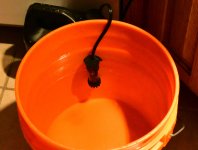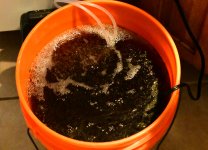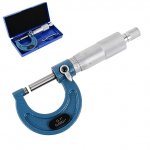Aloha fellow firewalkers!
It was in the Fall, October, in the early 80's. The time of the season to float the Rogue River in So. Oregon to catch half-pounders. https://fishbio.com/half-pounder-history/
If you don't want to hard-core camp on the river, there are 4 or 5 lodges along the river one can stay at. This was our option as it is the cool, rainy season and it is nice to sleep in a warm bed after a hot meal, some bourbon and a cigar over the bull-shitting. Some die-hard fishing buddies and me would make the yearly trek to participate in some of the finest fishing in the world.
Since the time of Zane Grey the river was famous for it's salmon and steelhead fishery. In those olden days, tradition had it that double hooks were used in the making of flies for this endeavor. Not necessarily to increase fishing deadliness but the extra weight of the hook got the fly down to the right depth to attract these shiny, beautiful creatures returning from the ocean after their 2-year walkabout.
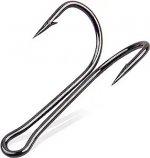
Today, people have gotten over that superstition. They use sinking lines to accomplish this.
On these 3 days spent on the river, not a single fish rose to these double hook patterns. When we got back to the lodge for lunch on the second day, I pulled out my fly-tying vise and quick tied up some of my tried and true royal coachmans. A very old pattern, it has worked when all else has failed.

I also tied some stonefly patterns similar to this.
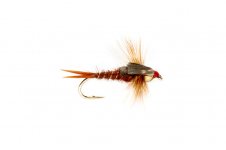
I slaughtered them that afternoon to the chagrin of my guide as I was using something heretical on "his" river. During one of our pee breaks, pulling up to the shore for that brief moment of relief, I saw this laying on the rocks close to the water.
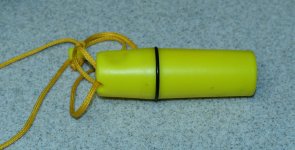
I retrieved it and found that it was filled with cannabis seeds! I don't know why I didn't plant them right away just one of those things. I did plant some in 2000, but my sister got nervous and cut them down. Grrr! I haven't talked with her in years
Anyway, here today with old, old seeds that this dumb-ass took for granted. How was I to know that people would covet these above all others? Now are they skunk, the real skunk? I don't know as I have not grown it out completely. But they did come from that era. And so finally, I am motivated to find out. There are so many ways and opinions as to how to resuscitate, revive, resurrect but I am reluctant to try all as I only have so much of this commodity and want to minimize any mistakes or errors. I found this article some time ago and thought I'd share so you could understand my thinking on this (next post). The seeds are in the fridge as we speak as I continue to read and learn what might be the best way to bring these precious seeds to life. Stay tuned.
mu
It was in the Fall, October, in the early 80's. The time of the season to float the Rogue River in So. Oregon to catch half-pounders. https://fishbio.com/half-pounder-history/
If you don't want to hard-core camp on the river, there are 4 or 5 lodges along the river one can stay at. This was our option as it is the cool, rainy season and it is nice to sleep in a warm bed after a hot meal, some bourbon and a cigar over the bull-shitting. Some die-hard fishing buddies and me would make the yearly trek to participate in some of the finest fishing in the world.
Since the time of Zane Grey the river was famous for it's salmon and steelhead fishery. In those olden days, tradition had it that double hooks were used in the making of flies for this endeavor. Not necessarily to increase fishing deadliness but the extra weight of the hook got the fly down to the right depth to attract these shiny, beautiful creatures returning from the ocean after their 2-year walkabout.

Today, people have gotten over that superstition. They use sinking lines to accomplish this.
On these 3 days spent on the river, not a single fish rose to these double hook patterns. When we got back to the lodge for lunch on the second day, I pulled out my fly-tying vise and quick tied up some of my tried and true royal coachmans. A very old pattern, it has worked when all else has failed.

I also tied some stonefly patterns similar to this.

I slaughtered them that afternoon to the chagrin of my guide as I was using something heretical on "his" river. During one of our pee breaks, pulling up to the shore for that brief moment of relief, I saw this laying on the rocks close to the water.

I retrieved it and found that it was filled with cannabis seeds! I don't know why I didn't plant them right away just one of those things. I did plant some in 2000, but my sister got nervous and cut them down. Grrr! I haven't talked with her in years
Anyway, here today with old, old seeds that this dumb-ass took for granted. How was I to know that people would covet these above all others? Now are they skunk, the real skunk? I don't know as I have not grown it out completely. But they did come from that era. And so finally, I am motivated to find out. There are so many ways and opinions as to how to resuscitate, revive, resurrect but I am reluctant to try all as I only have so much of this commodity and want to minimize any mistakes or errors. I found this article some time ago and thought I'd share so you could understand my thinking on this (next post). The seeds are in the fridge as we speak as I continue to read and learn what might be the best way to bring these precious seeds to life. Stay tuned.
mu

